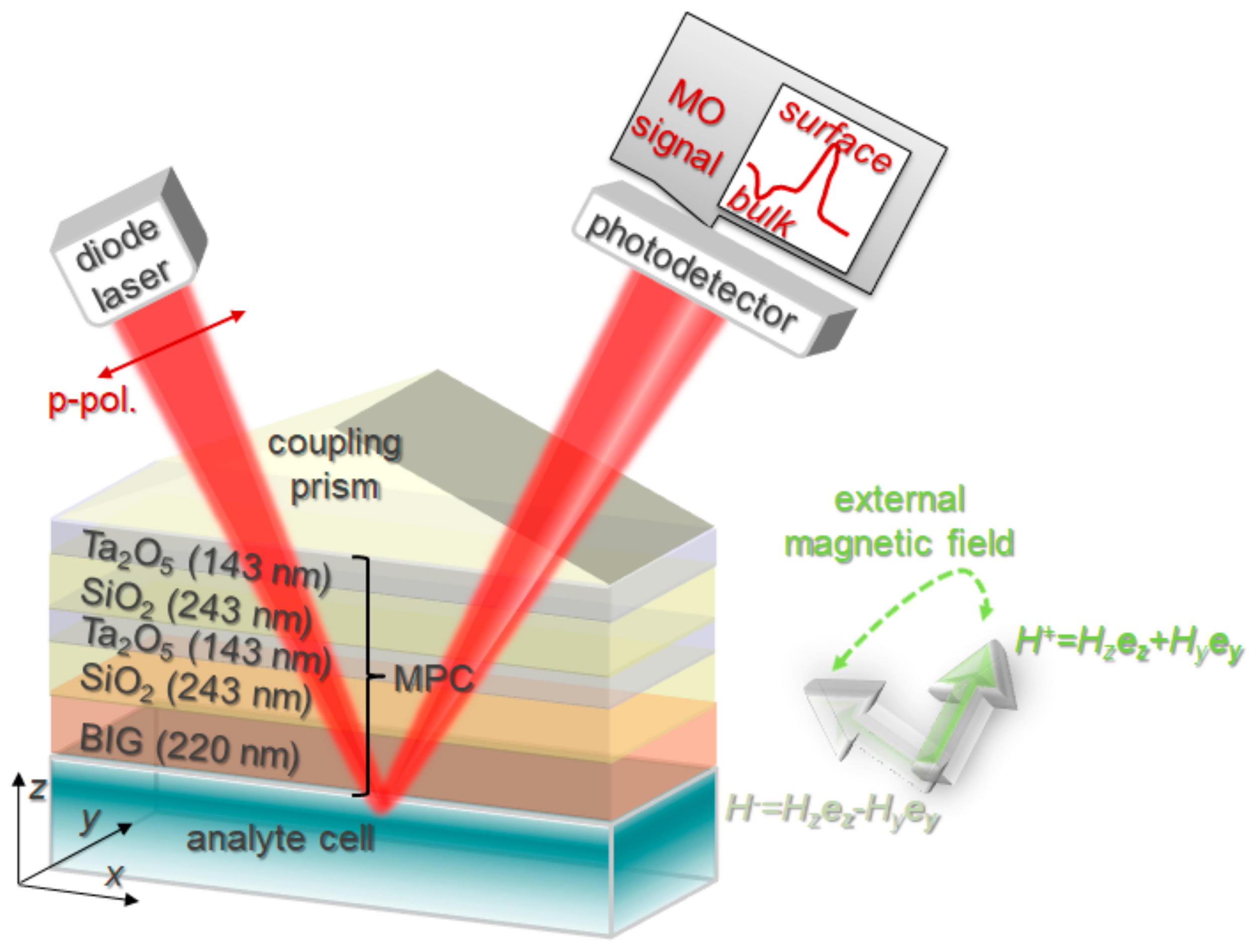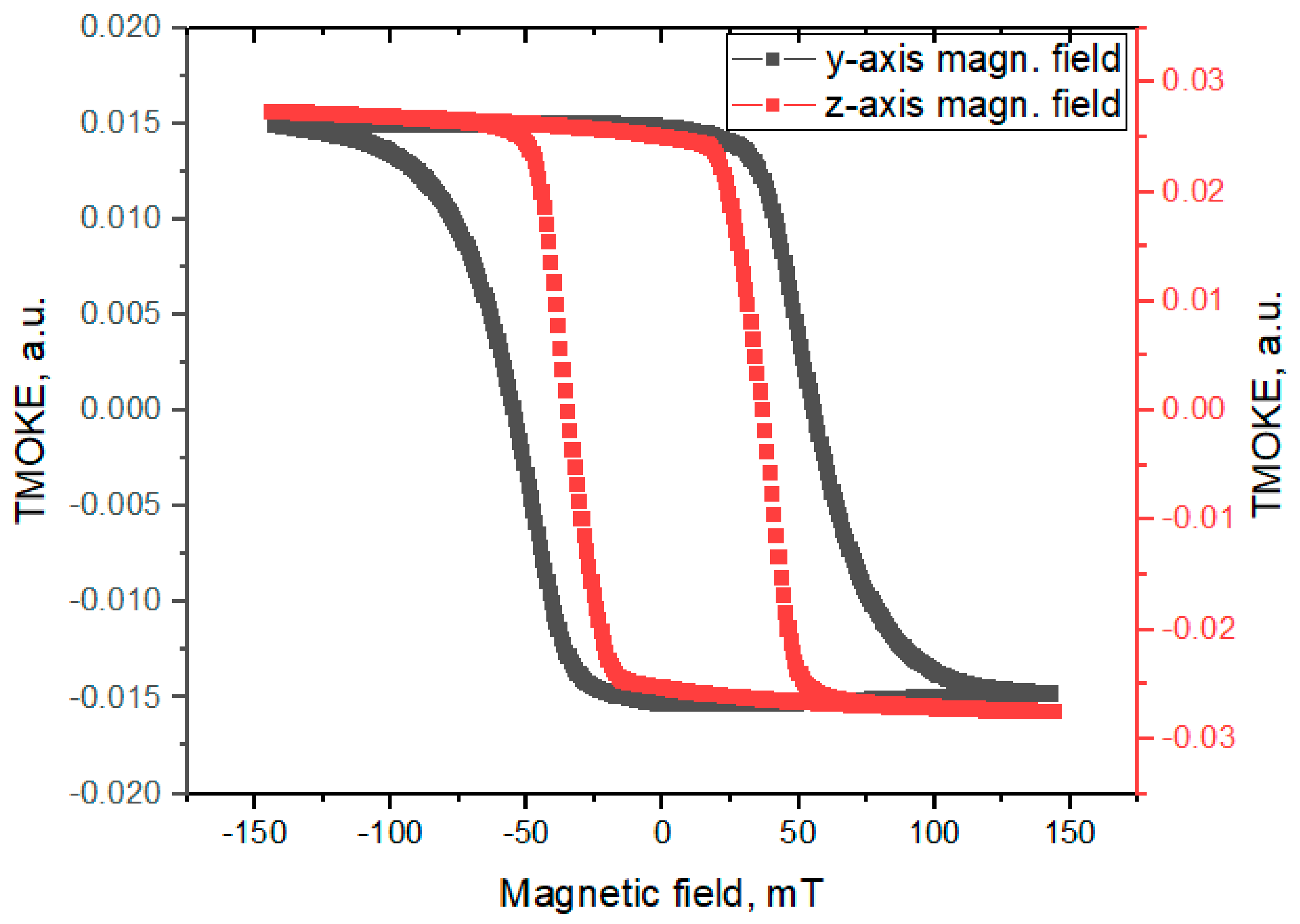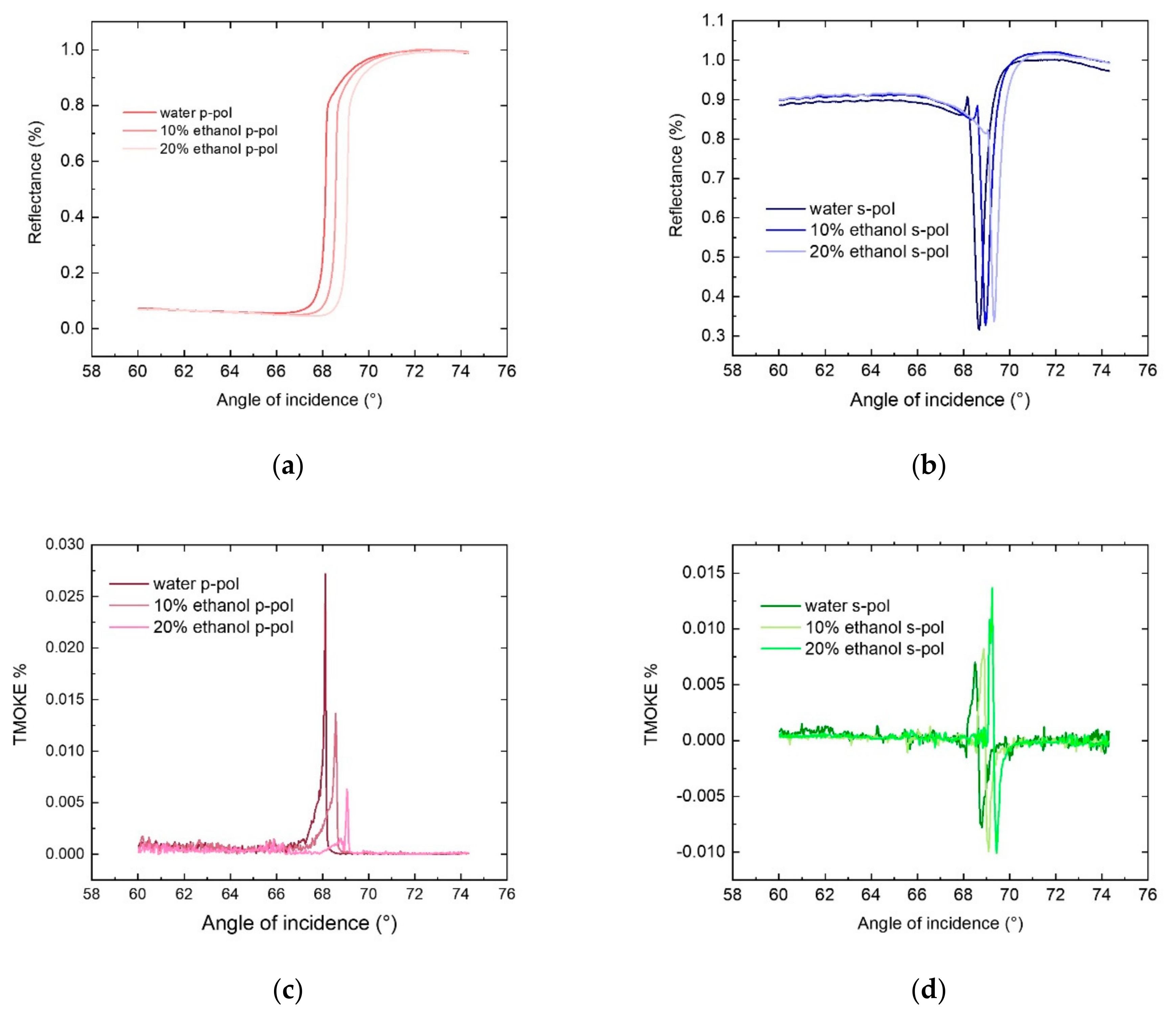Sensing of Surface and Bulk Refractive Index Using Magnetophotonic Crystal with Hybrid Magneto-Optical Response
Abstract
1. Introduction
2. Materials and Methods
3. Results
4. Discussion
Author Contributions
Funding
Informed Consent Statement
Data Availability Statement
Acknowledgments
Conflicts of Interest
References
- Homola, J. Surface plasmon resonance sensors for detection of chemical and biological species. Chem. Rev. 2008, 108, 462–493. [Google Scholar] [CrossRef] [PubMed]
- Herreño-Fierro, C.A.; Patiño, E.J.; Armelles, G.; Cebollada, A. Surface sensitivity of optical and magneto-optical and ellipsometric properties in magnetoplasmonic nanodisks. Appl. Phys. Lett. 2016, 108, 021109. [Google Scholar] [CrossRef]
- Maccaferri, N.; Gregorczyk, K.E.; de Oliveira, T.A.G.; Kataja, M.; van Dijken, S.; Pirzadeh, Z.; Dmitriev, A.; Åkerman, J.; Knez, M.; Vavassori, P. Ultrasensitive and label-free molecular-level detection enabled by light phase control in magnetoplasmonic nanoantennas. Nat. Commun. 2015, 6, 6150. [Google Scholar] [CrossRef] [PubMed]
- Rostova, E.; Adiba, C.B.; Dietler, G.; Sekatskii, S. Kinetics of Antibody Binding to Membranes of Living Bacteria Measured by a Photonic Crystal-Based Biosensor. Biosensors 2016, 6, 52. [Google Scholar] [CrossRef] [PubMed]
- Manera, M.G.; Ferreiro-Vila, E.; Garcia-Martin, J.M.; Garcia-Martin, A.; Rella, R. Enhanced antibody recognition with a magneto-optic surface plasmon resonance (MO-SPR) sensor. Biosens. Bioelectron. 2014, 58, 114–120. [Google Scholar] [CrossRef]
- Slavík, R.; Homola, J. Ultrahigh resolution long range surface plasmon-based sensor. Sens. Actuators B 2007, 123, 10–12. [Google Scholar] [CrossRef]
- Ruan, B.; You, Q.; Zhu, J.; Wu, L.; Guo, J.; Dai, X.; Xiang, Y. Improving the performance of an SPR biosensor using long-range surface plasmon of Ga-doped zinc oxide. Sensors 2018, 18, 2098. [Google Scholar] [CrossRef]
- Wark, A.W.; Lee, H.J.; Corn, R.M. Long-range surface plasmon resonance imaging for bioaffinity sensors. Anal. Chem. 2005, 77, 3904–3907. [Google Scholar] [CrossRef]
- Qin, J.; Zhang, Y.; Liang, X.; Liu, C.; Wang, C.; Kang, T.; Lu, H.; Zhang, L.S.; Zhou, P.; Wang, X.; et al. Ultrahigh figure-of-merit in metal-insulator-metal magnetoplasmonic sensors using low loss magneto-optical oxide thin films. ACS Photon. 2017, 4, 1403–1412. [Google Scholar] [CrossRef]
- Floess, D.; Chin, J.Y.; Kawatani, A.; Dregely, D.; Habermeier, H.U.; Weiss, T.; Giessen, H. Tunable and switchable polarization rotation with non-reciprocal plasmonic thin films at designated wavelengths. Light Sci. Appl. 2015, 4, e284. [Google Scholar] [CrossRef]
- Sasin, M.E.; Seisyan, R.P.; Kalitteevski, M.A.; Brand, S.; Abram, R.A.; Chamberlain, J.M.; Egorov, A.Y.; Vasil’ev, A.P.; Mikhrin, V.S.; Kavokin, A.V. Tamm plasmon polaritons: Slow and spatially compact light. Appl. Phys. Lett. 2008, 92, 251112. [Google Scholar] [CrossRef]
- Pankin, P.S.; Vetrov, S.Y.; Timofeev, I.V. Tunable hybrid Tamm-microcavity states. J. Opt. Soc. Am. B 2017, 34, 2633–2639. [Google Scholar] [CrossRef]
- Konopsky, V.N.; Alieva, E.V. Long-range propagation of plasmon polaritons in a thin metal film on a one-dimensional photonic crystal surface. Phys. Rev. Lett. 2006, 97, 253904. [Google Scholar] [CrossRef]
- Konopsky, V.N.; Alieva, E.V. Long-range plasmons in lossy metal films on photonic crystal surfaces. Opt. Lett. 2009, 34, 479–481. [Google Scholar] [CrossRef] [PubMed]
- Sekatskii, S.K.; Smirnov, S.; Dietler, G.; Alam, M.N.; Vasiliev, M.; Alameh, K. Photonic crystal-supported long-range surface plasmon-polaritons propagating along high-quality silver nanofilms. Appl. Sci. 2018, 8, 248. [Google Scholar] [CrossRef]
- Christofi, A.; Kawaguchi, Y.; Alù, A.; Khanikaev, A.B. Giant enhancement of Faraday rotation due to electromagnetically induced transparency in all-dielectric magneto-optical metasurfaces. Opt. Lett. 2018, 43, 1838–1841. [Google Scholar] [CrossRef] [PubMed]
- Konopsky, V.N.; Karakouz, T.; Alieva, E.V.; Vicario, C.; Sekatskii, S.K.; Dietler, G. Photonic crystal biosensor based on optical surface waves. Sensors 2013, 13, 2566–2578. [Google Scholar] [CrossRef]
- Konopsky, V.N.; Alieva, E.V. Photonic crystal surface waves for optical biosensors. Anal. Chem. 2007, 79, 4729–4735. [Google Scholar] [CrossRef] [PubMed]
- Martín-Becerra, D.; Armelles, G.; González, M.U.; García-Martín, A. Plasmonic and magnetoplasmonic interferometry for sensing. N. J. Phys. 2013, 15, 085021. [Google Scholar] [CrossRef]
- Armelles, G.; Cebollada, A.; García-Martín, A.; González, M.U. Magnetoplasmonics: Combining magnetic and plasmonic functionalities. Adv. Opt. Mat. 2013, 1, 10–35. [Google Scholar] [CrossRef]
- Regatos, D.; Fariña, D.; Calle, A.; Cebollada, A.; Sepúlveda, B.; Armelles, G.; Lechuga, L.M. Au/Fe/Au multilayer transducers for magneto-optic surface plasmon resonance sensing. J. Appl. Phys. 2010, 108, 054502. [Google Scholar] [CrossRef]
- Kalish, A.N.; Ignatyeva, D.O.; Belotelov, V.I.; Kreilkamp, L.E.; Akimov, I.A.; Achanta, V.G.; Bayer, M.; Sukhorukov, A.P. Transformation of mode polarization in gyrotropic plasmonic waveguides. Las. Phys. 2014, 24, 094006. [Google Scholar] [CrossRef]
- Zheludev, N.I.; Kivshar, Y.S. From metamaterials to metadevices. Nat. Mater. 2012, 11, 917–924. [Google Scholar] [CrossRef]
- Mao, R.; Wang, G.; Cai, T.; Hou, H.; Wang, D.; Wu, B.; Zhang, Q. Tunable metasurface with controllable polarizations and reflection/transmission properties. J. Phys. D Appl. Phys. 2020, 53, 155102. [Google Scholar] [CrossRef]
- Xiao, S.; Wang, T.; Liu, T.; Zhou, C.; Jiang, X.; Zhang, J. Active metamaterials and metadevices: A review. J. Phys. D Appl. Phys. 2020, 53, 503002. [Google Scholar] [CrossRef]
- Chernov, A.I.; Kozhaev, M.A.; Ignatyeva, D.O.; Beginin, E.N.; Sadovnikov, A.V.; Voronov, A.A.; Karki, D.; Levy, M.; Belotelov, V.I. All-dielectric nanophotonics enables tunable excitation of the exchange spin waves. Nano Lett. 2020, 20, 5259–5266. [Google Scholar] [CrossRef]
- Khramova, A.E.; Ignatyeva, D.O.; Kozhaev, M.A.; Dagesyan, S.A.; Berzhansky, V.N.; Shaposhnikov, A.N.; Tomilin, S.V.; Belotelov, V.I. Resonances of the magneto-optical intensity effect mediated by interaction of different modes in a hybrid magnetoplasmonic heterostructure with gold nanoparticles. Opt. Express 2019, 27, 33170–33179. [Google Scholar] [CrossRef]
- Kuzmichev, A.N.; Sylgacheva, D.A.; Kozhaev, M.A.; Krichevsky, D.M.; Shaposhnikov, A.N.; Berzhansky, V.N.; Freire-Fernández, F.; Qin, H.J.; Popova, O.E.; Keller, N.; et al. Influence of the plasmonic nanodisk position inside a magnetic medium on the Faraday effect enhancement. Phys. Status Solidi Rapid Res. Lett. 2020, 14, 1900682. [Google Scholar] [CrossRef]
- Lodewijks, K.; Maccaferri, N.; Pakizeh, T.; Dumas, R.K.; Zubritskaya, I.; Åkerman, J.; Vavassori, P.; Dmitriev, A. Magnetoplasmonic design rules for active magneto-optics. Nano Lett. 2014, 14, 7207–7214. [Google Scholar] [CrossRef]
- Ignatyeva, D.O.; Knyazev, G.A.; Kapralov, P.O.; Dietler, G.; Sekatskii, S.K.; Belotelov, V.I. Magneto-optical plasmonic heterostructure with ultranarrow resonance for sensing applications. Sci. Rep. 2016, 6, 28077. [Google Scholar] [CrossRef] [PubMed]
- Ignatyeva, D.O.; Kapralov, P.O.; Knyazev, G.A.; Sekatskii, S.K.; Dietler, G.; Alam, M.N.; Vasiliev, M.; Alameh, K.; Belotelov, V.I. High-Q surface modes in photonic crystal/iron garnet film heterostructures for sensor applications. JETP Lett. 2016, 104, 679–684. [Google Scholar] [CrossRef]
- Borovkova, O.V.; Ignatyeva, D.O.; Sekatskii, S.K.; Karabchevsky, A.; Belotelov, V.I. High-Q surface electromagnetic wave resonance excitation in magnetophotonic crystals for supersensitive detection of weak light absorption in the near-infrared. Phot. Res. 2020, 8, 57–64. [Google Scholar] [CrossRef]
- Merzlikin, A.M.; Kuznetsov, E.V.; Baryshev, A.V. Magneto-optical device based on polarization sensitivity for perspective biosensing applications. IEEE Sens. J. 2018, 18, 5732–5738. [Google Scholar] [CrossRef]
- Konopsky, V.N. Plasmon-polariton waves in nanofilms on one-dimensional photonic crystal surfaces. New J. Phys. 2010, 12, 093006. [Google Scholar] [CrossRef]
- Višňovský, Š.; Nývlt, M.; Prosser, V.; Lopušník, R.; Urban, R.; Ferré, J.; Pénissard, G.; Renard, D.; Krishnan, R. Polar magneto-optics in simple ultrathin-magnetic-film structures. Phys. Rev. B 1995, 52, 1090. [Google Scholar] [CrossRef] [PubMed]
- Ignatyeva, D.O.; Kalish, A.N.; Levkina, G.Y.; Sukhorukov, A.P. Surface plasmon polaritons at gyrotropic interfaces. Phys. Rev. A 2012, 85, 043804. [Google Scholar] [CrossRef]
- Ignatyeva, D.O.; Karki, D.; Voronov, A.A.; Kozhaev, M.A.; Krichevsky, D.M.; Chernov, A.I.; Levy, M.; Belotelov, V.I. All-dielectric magnetic metasurface for advanced light control in dual polarizations combined with high-Q resonances. Nat. Comm. 2020, 11, 5487. [Google Scholar] [CrossRef]
- Rheims, J.; Köser, J.; Wriedt, T. Refractive-index measurements in the near-IR using an Abbe refractometer. Meas. Sci. Technol. 1997, 8, 601–605. [Google Scholar] [CrossRef]
- Daimon, M.; Masumura, A. Measurement of the refractive index of distilled water from the near-infrared region to the ultraviolet region. Appl. Opt. 2007, 46, 3811–3820. [Google Scholar] [CrossRef]
- Hongwei, L.; Colleen, L.N.; Jason, H.H. Biomedical applications of plasmon resonant metal nanoparticles. Nanomedicine 2006, 1, 2. [Google Scholar] [CrossRef]
- Anker, J.N.; Hall, W.P.; Lyandres, O.; Shah, N.C.; Zhao, J. Biosensing with plasmonic nanosensors. Nanosci. Technol. 2009. [Google Scholar] [CrossRef]
- Silvia, R.; Gianluigi, Z.; Stefania, T.; Giuseppe, C.; Erika, P.; Giuseppe, C.; Stefano, C.; Ivo, R.; Vito, M. Label-free sensing of ultralow-weight molecules with all-dielectric metasurfaces supportingbound states in the continuum. Phot. Res. 2018, 6, 726–733. [Google Scholar] [CrossRef]
- Noemi, B.; Sípová-Jungová, H.; Nils Länk, O.; Ruggero, V. Plasmonic versus all-dielectric nanoantennas for refractometric sensing: A direct comparison. ACS Photonics 2019, 6, 1556–1564. [Google Scholar] [CrossRef]




| Process Parameters | Values and Comments |
|---|---|
| Sputtering target stoichiometry oxide-mixed garnet targets | Bi2.1Dy0.9Fe3.9Ga1.1O12 |
| Base pressure | 4–5 × 10−6 Torr |
| Argon (Ar) pressure | ≈2 mTorr |
| Substrate stage temperature | Room temperature 21–23 °C |
| Substrate stage rotation rate | 16–17 rpm |
Publisher’s Note: MDPI stays neutral with regard to jurisdictional claims in published maps and institutional affiliations. |
© 2021 by the authors. Licensee MDPI, Basel, Switzerland. This article is an open access article distributed under the terms and conditions of the Creative Commons Attribution (CC BY) license (http://creativecommons.org/licenses/by/4.0/).
Share and Cite
Ignatyeva, D.; Kapralov, P.; Golovko, P.; Shilina, P.; Khramova, A.; Sekatskii, S.; Nur-E-Alam, M.; Alameh, K.; Vasiliev, M.; Kalish, A.; et al. Sensing of Surface and Bulk Refractive Index Using Magnetophotonic Crystal with Hybrid Magneto-Optical Response. Sensors 2021, 21, 1984. https://doi.org/10.3390/s21061984
Ignatyeva D, Kapralov P, Golovko P, Shilina P, Khramova A, Sekatskii S, Nur-E-Alam M, Alameh K, Vasiliev M, Kalish A, et al. Sensing of Surface and Bulk Refractive Index Using Magnetophotonic Crystal with Hybrid Magneto-Optical Response. Sensors. 2021; 21(6):1984. https://doi.org/10.3390/s21061984
Chicago/Turabian StyleIgnatyeva, Daria, Pavel Kapralov, Polina Golovko, Polina Shilina, Anastasiya Khramova, Sergey Sekatskii, Mohammad Nur-E-Alam, Kamal Alameh, Mikhail Vasiliev, Andrey Kalish, and et al. 2021. "Sensing of Surface and Bulk Refractive Index Using Magnetophotonic Crystal with Hybrid Magneto-Optical Response" Sensors 21, no. 6: 1984. https://doi.org/10.3390/s21061984
APA StyleIgnatyeva, D., Kapralov, P., Golovko, P., Shilina, P., Khramova, A., Sekatskii, S., Nur-E-Alam, M., Alameh, K., Vasiliev, M., Kalish, A., & Belotelov, V. (2021). Sensing of Surface and Bulk Refractive Index Using Magnetophotonic Crystal with Hybrid Magneto-Optical Response. Sensors, 21(6), 1984. https://doi.org/10.3390/s21061984









